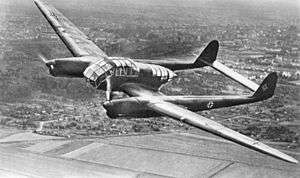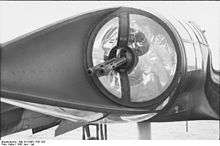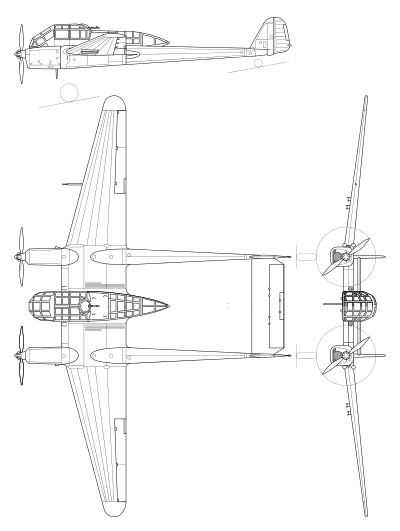Focke-Wulf Fw 189
| Fw 189 Uhu | |
|---|---|
 | |
| Role | Tactical Reconnaissance and Army Cooperation Aircraft, Light Bomber |
| Manufacturer | Focke-Wulf |
| Designer | Kurt Tank |
| First flight | July 1938 |
| Introduction | August 1941 |
| Retired | 1945 |
| Primary users | Luftwaffe Hungarian Air Force Slovak Air Force |
| Produced | 1940–44 |
| Number built | 864 |
The Focke-Wulf Fw 189 Uhu ("Eagle Owl") was a German twin-engine, twin-boom, three-seat tactical reconnaissance and army cooperation aircraft. It first flew in 1938 (Fw 189 V1), entered service in 1940 and was produced until mid-1944. It should not be confused with the Heinkel He 219 night fighter also named Uhu.
In addition, Focke-Wulf used this airframe in response to a tender request by the RLM for a dedicated ground-attack airplane, and later submitted an armored version for trials. However, the Henschel Hs 129 was selected instead.
Design and development
In 1937, the German Ministry of Aviation issued a specification for a short-range, three-seat reconnaissance aircraft with a good allround view to support the German army in the field, replacing the Henschel Hs 126, which had just entered service. A power of about 850–900 hp (630–670 kW) was specified. The specification was issued to Arado and Focke-Wulf.[1] Arado's design, the Ar 198, which was initially the preferred option, was a relatively conventional single-engined high-wing monoplane with a glazed gondola under the fuselage.[2] Focke-Wulf's chief designer Kurt Tank's design, the Fw 189, was a twin-boom design, powered by two Argus As 410 engines instead of with an expected single engine. As a "twin-boom" design like the earlier Dutch Fokker G.I from 1938, the Fw 189 used a central crew gondola for its crew accommodation, which for the Fw 189 would be designed with a heavily glazed and framed "stepless" cockpit forward section, which used no separate windscreen panels for the pilot (as with many German medium bombers from 1938 onwards). Blohm & Voss, however, proposed as a private venture something even more radical: chief designer Dr. Richard Vogt's unique asymmetric BV 141. Orders were placed for three prototypes, each of the Arado and Focke-Wulf designs, in April 1937.[3]
The Fw 189 was produced in large numbers, at the Focke-Wulf factory in Bremen, at the Bordeaux-Merignac aircraft factory (Avions Marcel Bloch's factory, which became Dassault Aviation after the war) in occupied France, then in the Aero Vodochody aircraft factory in Prague, occupied Czechoslovakia. Total production was 864 aircraft of all variants.[4]
Operational history
Called the Fliegende Auge ("Flying Eye") of the German Army, the Fw 189 was used extensively on the Eastern Front with great success. It was nicknamed "Rama" ("frame" in the Russian, Ukrainian and Polish languages) by Soviet forces, referring to its distinctive tailboom and stabilizer shapes, giving it the characteristic quadrangular appearance. Despite its low speed and fragile looks, the Fw 189's manoeuvrability made it a difficult target for attacking Soviet fighters. When attacked, the Fw 189 was often able to out-turn attacking fighters by simply flying in a tight circle into which enemy fighters could not follow.
Variants
The main production model was the Fw 189A reconnaissance plane, built mostly in two variants, the A-1 and A-2. Unless otherwise stated all aircraft were powered by two Argus As 410 engines of 465 PS (459 hp, 342 kW).
- Fw 189 A-0: Ten preproduction aircraft for operational tests and trials.
- Fw 189 A-1: Initial production version, armed with two flexible 7.92 mm (.312 in) MG 15 machine guns in the dorsal and rear positions, one 7.92 mm (0.312 in) MG 17 machine gun in each wing root, plus four 50 kg (110 lb) bombs. It could carry an Rb 20/30 or an Rb 50/30 aerial camera.
- Fw 189 A-1 trop: Tropicalised version of the Fw 189 A-1, fitted with air intake filters and survival equipment. Conversion from A-1s.

- Fw 189 A-1/U2: VIP transport version of the Fw 189 A-1.
- Fw 189 A-1/U3: VIP transport version of the Fw 189 A-1.
- Fw 189 A-2: The flexible MG 15s were replaced by twin-barrel 7.92 mm (0.312 in) MG 81Z.
- Fw 189 A-3: Tropicalised production version of the Fw 189 A-2, fitted with air intake filters and survival equipment.
- Fw 189 A-4: Light ground-attack version, armed with two 20 mm MG 151/20 cannons in each wing root, fitted with armour protection for the underside of the fuselage, engines and fuel tanks. No production known.
The Fw 189B was a five-seat training aircraft; only 13 were built.
- Fw 189 B-0: Three preproduction aircraft.
- Fw 189 B-1: Five-seat training version. ten built.
The Fw 189C was conceived as a heavily armoured ground-attack, close-support variant, in competition with the Henschel Hs 129. But its two prototypes (V1b and V6) were not satisfactory, and it was not produced.
- Fw 189D: Proposed twin-float trainer floatplane. Not built.
- Fw 189E: Prototype only, powered by two 700 PS (690 hp, 515 kW) Gnome-Rhone 14M radial engines.
- Fw 189 F-1: Re-engined Fw 189 A-1 aircraft, powered by two 600 PS (592 hp, 441 kW) Argus As 411 engines.
- Fw 189 F-2: Fitted with electrically-operated landing gear, increased fuel capacity and additional armour plating, powered by two 600 PS (592 hp, 441 kW) Argus As 411 engines.
Operators
- Royal Norwegian Air Force (Postwar)
Surviving aircraft
One Fw 189 survives today. Its story starts on May 4, 1943 when Fw 189 V7+1H (Werk Nr. 2100), of 1./Nahaufklärungsgruppe 10, with V7 originally the Geschwaderkennung code for Heeres-Aufklärungsgruppe 32 based at Pontsalenjoki (due east of Kuusamo, and within the south-central area of modern Russia's Republic of Karelia) took off on a mission to photograph the Loukhi-3 airbase from an altitude of 6,000 m (20,000 ft), then to continue north along the Murmansk-Leningrad railway. Approximately 31 minutes after taking off, V7+1H was attacked by Lend-Lease-acquired Soviet Hawker Hurricane fighters. The aircraft dived to escape the fighters, but owing to damage already suffered, could not pull out in time, and it struck the treetops. The tail was torn off, and the crew nacelle left hanging upside down within the trees. The pilot, Lothar Mothes, survived but one crewman was killed in the crash and the third died from blood loss as a result of a severed leg. Incredibly, Mothes was able to survive two weeks in sub-zero temperatures, evading Soviet patrols while eating bark and grubs as he walked back to his base. Mothes spent the next nine months in a hospital recovering from severe frostbite before returning to the front line, eventually to fly another 100 missions.
In 1991, the wreckage of V7+1H was found in the Russian forest where it had remained for 48 years. The aircraft was purchased by a group of British aircraft enthusiasts and was shipped to the UK, arriving in the town of Worthing, West Sussex in March 1992. The Focke Wulf 189 Restoration Society was formed to restore the aircraft to flying condition. Her former pilot, Lothar Mothes, met up again with his aircraft at the 1996 Biggin Hill Airshow.
It was reported that this aircraft was acquired by Paul Allen’s Flying Heritage Collection. However, its current state is not publicly known.
Specifications (Fw 189 A-1)

General characteristics
- Crew: three
- Length: 12 m (39 ft 4 in)
- Wingspan: 18.4 m (60 ft 4 in)
- Height: 3.7 m (12 ft 0 in)
- Wing area: 38 m² (409 ft²)
- Empty weight: 2,680 kg (5,920 lb)
- Loaded weight: 3,950 kg (8,708 lb)
- Powerplant: 2 × Argus As 410, 342 kW (465 PS - 459 hp) each
Performance
- Maximum speed: 357 km/h at 2,600 m (222 mph at 8,530 ft)
- Range: 670 km (416 mi)
- Service ceiling: 8,400 m (27,550 ft)
- Rate of climb: 8.3 m/s (1,640 ft/min)
- Wing loading: 103.9 kg/m² (21.3 lb/ft²)
- Power/mass: 86.6 W/kg (0.053 hp/lb)
Armament
- 2 × 7.92 mm (.312 in) MG 17 machine guns mounted in the wing roots, firing forward
- 1 × 7.92 mm (.312 in) MG 15 machine gun in dorsal position, flexible mount, firing rearwards
- 1 × 7.92 mm (.312 in) MG 15 in rear cone, flexible mount, firing rearwards (optional)
- In later versions, MG 15 were replaced with 7.92 mm (.312 in) MG 81Z twin-barrel machine gun
- 4 × 50 kg (110 lb) bombs
See also
- Aircraft of comparable role, configuration and era
- Related lists
References
Notes
- ↑ Green & Swanborough 1988, p. 25.
- ↑ Smith & Kay 1972, pp. 66–67.
- ↑ Green & Swanborough 1988, p. 26.
- ↑ Smith & Kay 1972, p. 172.
Bibliography
- Brown, Capt. Eric (CBE, DSC, AFC, RN) (1978). Wings of the Luftwaffe. Garden City, NY: Doubleday & Co. ISBN 0-385-13521-1..
- Green, William (1979) [1970]. Warplanes of the Third Reich (fourth impression ed.). London: Macdonald and Jane's. ISBN 0-356-02382-6..
- Green, William; Swanborough, Gordon (September–December 1988). "Das Fliegende Auge... Focke Wulf's Versatile Owl". Air Enthusiast. Bromley, UK: Fine Scroll (Thirty-seven): 25–38. ISSN 0143-5450..
- Kucera, Pavel (1996). Focke-Wulf Fw 189 (in Czech and English). Prague, CZ: MBI. ISBN 80-901263-6-7..
- Punka, George (1993). Focke-Wulf Fw 189 in Action (Aircraft Number 142). Carrollton, TX: Squadron/Signal. ISBN 0-89747-310-8..
- Smith, J Richard (1973). Focke-Wulf, an Aircraft Album. Shepperton, Surrey, UK: Ian Allan. ISBN 0-7110-0425-0..
- Smith, J Richard; Kay, Anthony (1978) [1972], German Aircraft of the Second World War (third impression ed.), London: Putnam & Co, ISBN 0-370-00024-2.
- Wood, Anthony ‘Tony’; Gunston, William ‘Bill’ (1977). Hitler's Luftwaffe: A pictorial history and technical encyclopedia of Hitler's air power in World War II. London: Salamander. ISBN 0-86101-005-1..
External links
| Wikimedia Commons has media related to Focke-Wulf Fw 189. |
- Nutkins, Geoffrey ‘Geoff’. "Sky Spy" (painting). Aviart.. Fw 189 V7+IH's final mission.
- "Flugzeuge" (photo gallery). DE: Lufarchive.
|contribution=ignored (help) including the radial-engined E model. - Hecklafette 15A & B (manual). Scribd. for the Fw 189's rear gun turret.